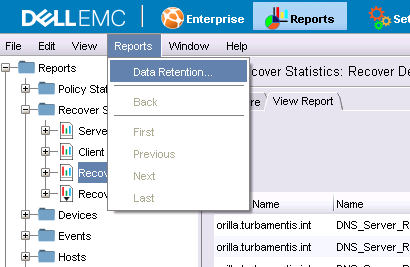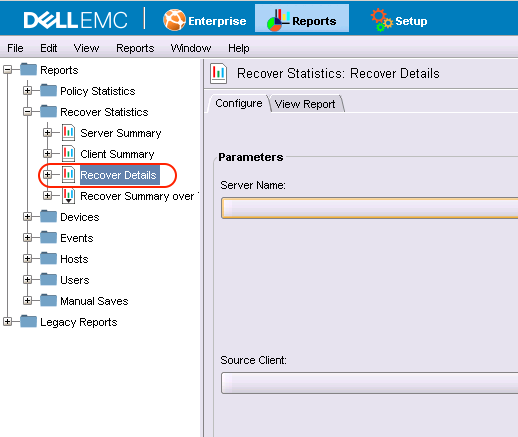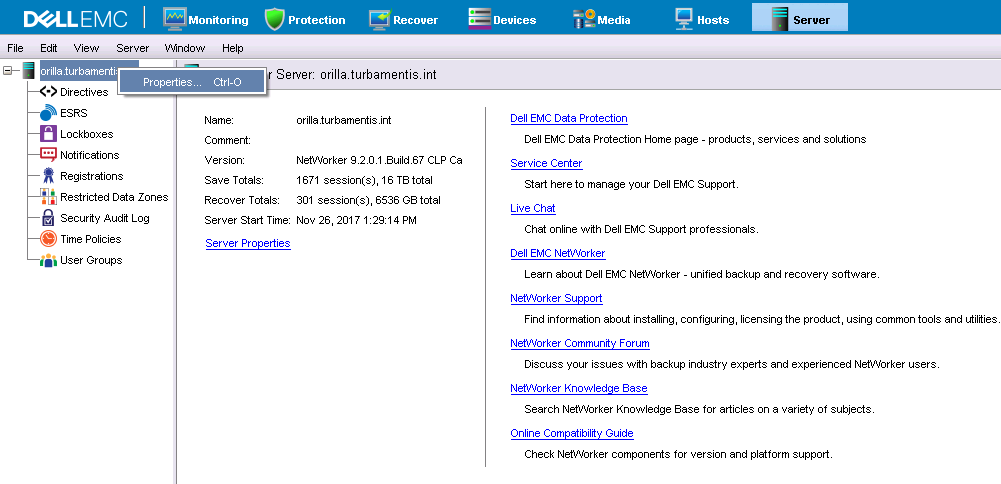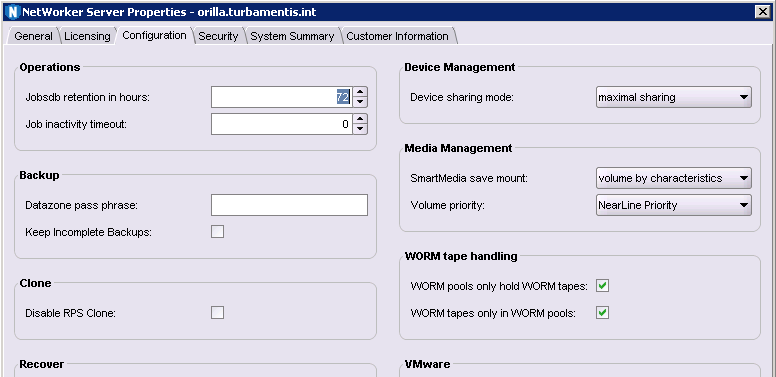If you need to find out details about what has recently been recovered with a NetWorker server, there’s a few different ways to achieve it.
NMC, of course, offers recovery reports. These are particularly good if you’ve got admins (e.g., security/audit people) who only access NetWorker via NMC – and good as a baseline report for auditing teams. Remember that NMC will retain records for reporting for a user defined period of time, via the Reports | Reports | Data Retention setting:
The actual report you’ll usually want to run for recovery details is the ‘Recover Details’ report:
The other way you can go about it is to use the command nsrreccomp, which retrieves details about completed recoveries from the NetWorker jobs database. Now, the jobs database is typically pruned every 72 hours in a default install (you can change the length of time on the jobs database). Getting a list of completed recoveries (successful or otherwise) is as simple as running the command nsrreccomp -L:
[root@orilla tmp]# nsrreccomp -L name, start time, job id, completion status recover, Tue Dec 19 10:28:25 2017(1513639705), 838396, succeeded DNS_Serv_Rec_20171219, Tue Dec 19 10:39:19 2017(1513640359), 838404, failed DNS_Server_Rec_20171219_2, Tue Dec 19 10:41:48 2017(1513640508), 838410, failed DNS_Server_Rec_20171219_3, Tue Dec 19 10:43:55 2017(1513640635), 838418, failed DNS_Server_Rec_20171219, Tue Dec 19 10:47:43 2017(1513640863), 838424, succeeded
You can see in the above list that I made a few recovery attempts that generated failures (deliberately picking a standalone ESX server that didn’t have a vProxy to service it as a recovery target, then twice forgetting to change my recovery destination) so that we could see the list includes successful and failed jobs.
You’ll note the second last field in each line of output is actually the Job ID associated with the recovery. You can actually use this with nsrreccomp to retrieve the full output of an individual job, viz.:
[root@orilla tmp]# nsrreccomp -R 838396 Recovering 1 file from /tmp/ into /tmp/recovery Volumes needed (all on-line): Backup.01 at Backup_01 Total estimated disk space needed for recover is 8 KB. Requesting 1 file(s), this may take a while... Recover start time: Tue 19 Dec 2017 10:28:25 AEDT Requesting 1 recover session(s) from server. 129290:recover: Successfully established direct file retrieve session for save-set ID '1345653443' with adv_file volume 'Backup.01'. ./tostage.txt Received 1 file(s) from NSR server `orilla' Recover completion time: Tue 19 Dec 2017 10:28:25 AEDT
The show-text option can be used for any recovery performed. For a virtual machine recovery it’ll be quite verbose – a snippet is as follows:
[root@orilla tmp]# nsrreccomp -R 838424
Initiating virtual machine 'krell_20171219' recovery on vCenter caprica.turbamentis.int using vProxy langara.turbamentis.int.
152791:nsrvproxy_recover: vProxy Log Begins ===============================================
159373:nsrvproxy_recover: vProxy Log: 2017/12/19 10:47:19 NOTICE: [@(#) Build number: 67] Logging to '/opt/emc/vproxy/runtime/logs/vrecoverd/RecoverVM-5e9719e5-61bf-4e56-9b68-b4931e2af5b2.log' on host 'langara'.
159373:nsrvproxy_recover: vProxy Log: 2017/12/19 10:47:19 NOTICE: [@(#) Build number: 67] Release: '2.1.0-17_1', Build number: '1', Build date: '2017-06-21T21:02:28Z'
159373:nsrvproxy_recover: vProxy Log: 2017/12/19 10:47:19 NOTICE: [@(#) Build number: 67] Changing log level from INFO to TRACE.
159373:nsrvproxy_recover: vProxy Log: 2017/12/19 10:47:19 INFO: [@(#) Build number: 67] Created RecoverVM session for "krell_20171219", logging to "/opt/emc/vproxy/runtime/logs/vrecoverd/RecoverVM-5e9719e5-61bf-4e56-9b68-b4931e2af5b2.log"...
159373:nsrvproxy_recover: vProxy Log: 2017/12/19 10:47:19 NOTICE: [@(#) Build number: 67] Starting restore of VM "krell_20171219". Logging at level "TRACE" ...
159373:nsrvproxy_recover: vProxy Log: 2017/12/19 10:47:19 NOTICE: [@(#) Build number: 67] RecoverVmSessions supplied by client:
159373:nsrvproxy_recover: vProxy Log: 2017/12/19 10:47:19 NOTICE: [@(#) Build number: 67] {
159373:nsrvproxy_recover: vProxy Log: 2017/12/19 10:47:19 NOTICE: [@(#) Build number: 67] "Config": {
159373:nsrvproxy_recover: vProxy Log: 2017/12/19 10:47:19 NOTICE: [@(#) Build number: 67] "SessionId": "5e9719e5-61bf-4e56-9b68-b4931e2af5b2",
159373:nsrvproxy_recover: vProxy Log: 2017/12/19 10:47:19 NOTICE: [@(#) Build number: 67] "LogTag": "@(#) Build number: 67",
Now, if you’d like more than 72 hours retention in your jobs database, you can set it to a longer period of time (though don’t get too excessive – you’re better off capturing jobs database details periodically and saving to an alternate location than trying to get the NetWorker server to retain a huge jobs database) via the server properties. This can be done using nsradmin or NMC – NMC shown below for reference:
There’s not much else to grabbing recovery results out of NetWorker – it’s certainly useful to know of both the NMC and command line options available to you. (Of course, if you want maximum flexibility on recovery reporting, you should definitely check out Data Protection Advisor (DPA), which is available automatically under any of the Data Protection Suite licensing models.)




